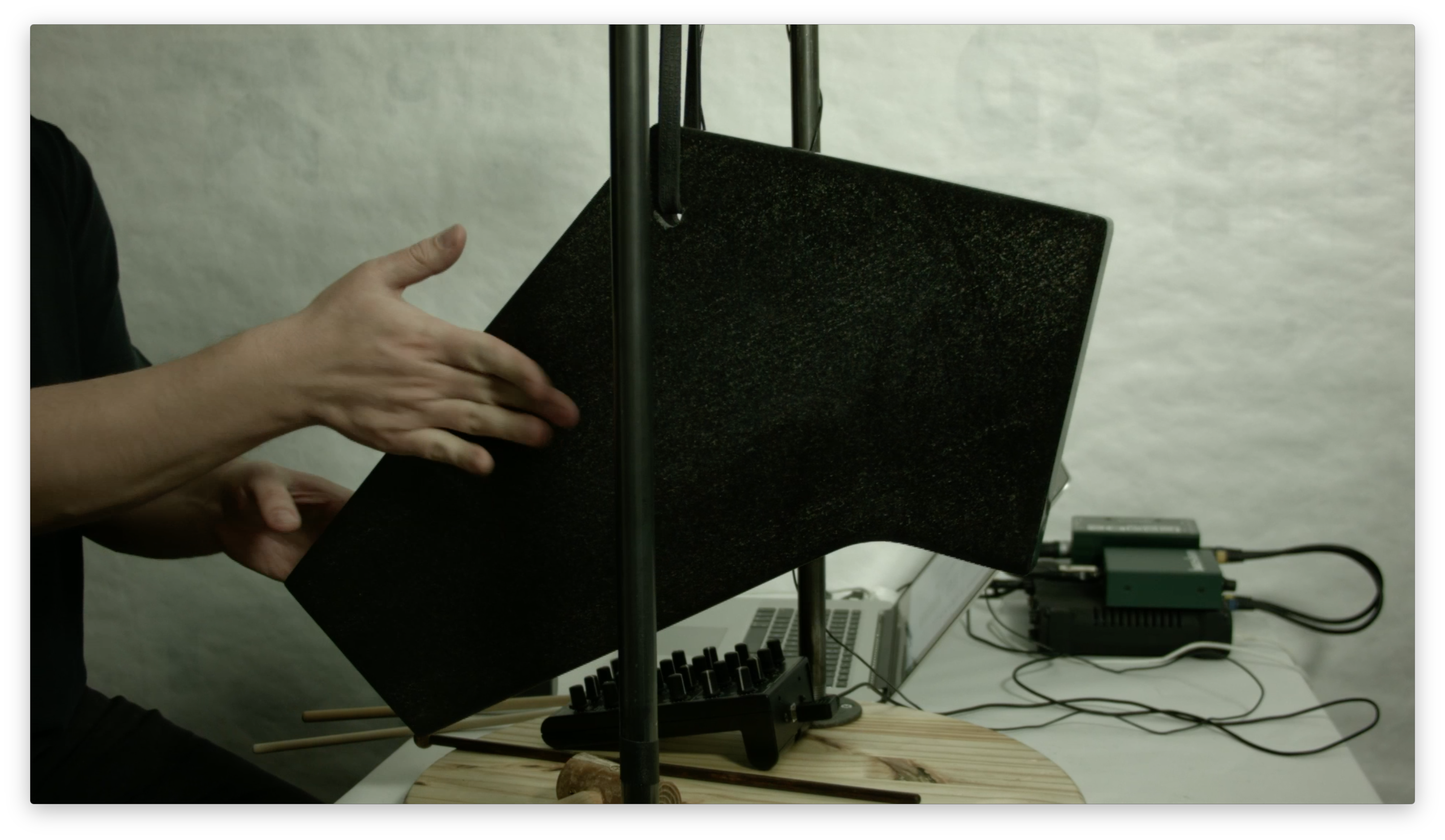Substitutions (2015)
Substitutions is inspired by a Chinese lithophone within the Museum of the Rhode Island School of Design’s Asian collection. Lithophones are ancient instruments, stones that vibrate and produce sound when struck. The RISD Museum’s Lithophone (or qing) is an L-shaped jade stone dating from 1761, created during the Qing Dynasty. The Museum piece is not available to be handled (or struck for that matter). In order to compose for this instrument within a computer music context,
I fabricated an approximation in granite for use as a percussive interface for sound synthesis and signal processing.
I fabricated an approximation in granite for use as a percussive interface for sound synthesis and signal processing.
In the performance of Substitutions, a Barcus-Berry Planar Wave piezo transducer is fixed to the stone’s vertex between the drum and femur. The transducer’s signal is sent to custom software created in the programming language Pure Data (Pd). In software, two computational substitutions take place. First, a real-time sinusoidal analysis of the audio signal is conducted. This analysis is used to drive a re-synthesis procedure with an oscillator bank. Thus, spectral information is used to produce drifting, sustained tones initiated by and fluctuating with percussive actions. The second substitution is created via convolution reverb. Pre-recorded impulse responses from metallic percussion instruments are used to change the perceived material quality of the stone chime. Sonically, the qing becomes gong. I performed Substitutions on December 4, 2014 and February 26, 2015 at the RISD Museum and later authored a short text about it for the Museum’s online publication Manual. This work was performed at the International Conference on New Interfaces for Musical Expression (2015 LSU, Baton Rouge).
![︎︎︎ Demonstration December 4. 2014, RISD Museum]()




The original qing (L-shaped lithophone) was likely adapted from agricultural ploughshare stones and used for signaling over distances to mark time, summon people, and for sounding warnings. Later, these concussion idiophones were arranged for ritual court music in pitch-ranged sets featuring 12, 16, or 32 qing. According to the inscriptions on the RISD Museum’s Lithophone, it is the pitch nanlü, the 10th stone in a set of 12. In the second month of autumn, it would be used to mark the end of each musical movement during important ceremonies. With the dissolution of the Qing Dynasty by 1912, instruments specific to court rituals, like qing, fell out of use. At the end of the 19th century, sets were broken up and sold. Qing Dynasty lithophones are scattered across private and public collections in the United States. The Chinese lithophone shares many characteristics with the Korean pyeongyeong. Notably there is a geometrical effect on the stone’s tuning, with the top obtuse angle being a primary factor. The long leg is known as the “drum,” and the shorter leg, the “femur” or “thigh.”
Traditional playing technique is with a wooden mallet and use of either striking or tapping gestures.
My stone instrument is close to the original in terms of dimensions. The biggest differences are the material used (granite vs. jade) and the position of the bottom curve. Otherwise, original angles and measurements were followed. As fabricated, the stone’s fundamental frequency is 690 Hz, not a match to the original which, according to the literature, should be near 440 Hz. Differences were expected, especially given the material choice; the goal was not an exact replica.
My stone instrument is close to the original in terms of dimensions. The biggest differences are the material used (granite vs. jade) and the position of the bottom curve. Otherwise, original angles and measurements were followed. As fabricated, the stone’s fundamental frequency is 690 Hz, not a match to the original which, according to the literature, should be near 440 Hz. Differences were expected, especially given the material choice; the goal was not an exact replica.

